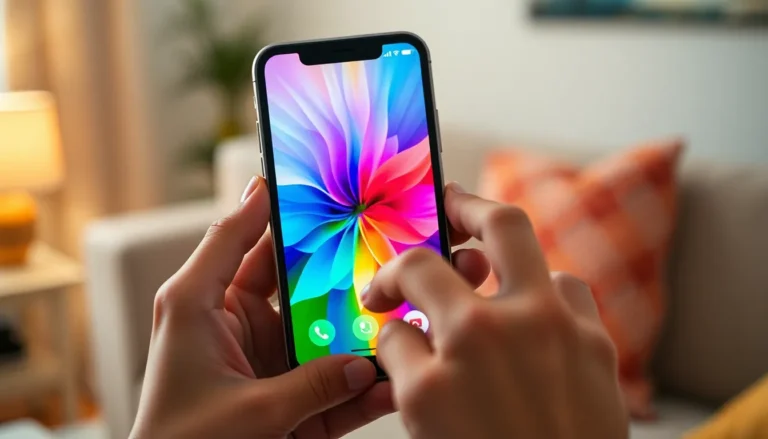Table of Contents
ToggleIn a world where everyone’s vying for attention, why should your iPhone be any different? Making it discoverable isn’t just a techy trick; it’s your ticket to seamless connections with friends, family, and that mysterious Bluetooth speaker you’ve been eyeing. Imagine walking into a café and effortlessly syncing your device to the latest playlist, all while looking like the tech-savvy superstar you are.
Understanding Discoverability on iPhone
Discoverability on iPhone refers to the ability of your device to be found by other Bluetooth-enabled devices. Users benefit from enabling discoverability, as it allows for seamless connections with peripherals like headphones, speakers, or other iPhones. This feature plays a crucial role in social interactions, making it easy to share music or connect to accessories.
To make an iPhone discoverable, users must access the Bluetooth settings. Once in the Bluetooth menu, enabling the feature connects the device to other peripherals. Devices searching for connections typically display nearby items, facilitating quick pairing.
Managing discoverability settings remains essential for controlling connectivity. A user may choose to keep their iPhone visible to everyone or limit visibility to known devices. Adjusting these settings often helps users maintain privacy while ensuring accessibility.
Being discoverable also involves factors like proximity. Both devices must remain close for effective pairing. The Bluetooth range typically extends up to 30 feet, but distance can impact connection quality. Interference from walls, furniture, and other electronic devices may reduce this effective range.
While playing music or sharing files, an iPhone needs to be discoverable. Engagement in tech-savvy activities gains popularity in social settings. Users often appreciate making their devices visible to enhance connectivity options, showcasing their device’s capabilities.
Recognizing when to toggle discoverability becomes important. Users may want to turn off discoverability after exiting a connection to maintain privacy. Enabling and disabling this feature as needed allows for more controlled use of the iPhone in various scenarios.
Enabling Bluetooth on Your iPhone


Enabling Bluetooth on an iPhone makes the device discoverable for seamless connections with other Bluetooth-enabled devices. This process involves accessing the settings and toggling the Bluetooth feature.
Accessing Settings
Open the Settings app on your iPhone to begin. Locate the icon—it looks like gears turning. Tap the icon to enter the settings menu. Scroll down until you find the Bluetooth option. This section allows users to manage Bluetooth connectivity settings easily.
Turning On Bluetooth
Once in the Bluetooth settings, look for the toggle switch at the top of the screen. This switch controls Bluetooth functionality. Slide the toggle to the right to turn Bluetooth on. When it’s active, the iPhone becomes discoverable to nearby devices. Watch for the message indicating Bluetooth is now on, confirming increased connectivity options.
Making Your iPhone Discoverable
Making your iPhone discoverable allows it to connect seamlessly with other Bluetooth-enabled devices. This function enhances accessibility and promotes an enjoyable tech experience.
Adjusting Bluetooth Visibility
Adjusting Bluetooth visibility is essential for effective device pairing. Access the Settings app, then select Bluetooth. Toggle the Bluetooth switch to the on position. The iPhone now becomes visible to nearby devices, enabling quick connections. It’s wise to manage this setting based on proximity and need. When finished, toggle Bluetooth off to ensure privacy.
Pairing with Other Devices
Pairing with other devices involves a simple process. First, ensure Bluetooth is activated on the iPhone. Nearby devices that are discoverable will appear on the screen. Tap the desired device to initiate pairing. Confirm any prompts that may appear, solidifying the connection. For convenience, once paired, the iPhone automatically reconnects to recognized devices in range. Pairing allows access to features like audio playback and file sharing.
Troubleshooting Discoverability Issues
Discoverability issues on iPhone can arise, leading to frustration during connectivity attempts. Addressing these issues efficiently enhances overall user experience.
Common Problems and Solutions
Users may encounter various problems while trying to make their iPhones discoverable. For instance, Bluetooth may not turn on due to software glitches. Restarting the device often resolves this issue. Connecting to multiple devices simultaneously can also cause disruptions. Limiting active connections can improve performance.
Device visibility might be affected by proximity. Staying within a 30-foot range while minimizing obstacles enhances detection. Other connected devices could interfere with Bluetooth signals. Disconnecting unused devices may help.
Lastly, outdated software can lead to incompatibility. Regularly checking for updates through the Settings app keeps devices running smoothly. Ensuring the settings align with the requirements often resolves these common discoverability issues.
Making an iPhone discoverable is a straightforward process that enhances connectivity with various devices. By adjusting Bluetooth settings users can easily sync with headphones speakers and other peripherals while maintaining control over their privacy.
Understanding the importance of proximity and managing connections ensures a seamless experience whether in social settings or during daily activities. Regularly updating software and troubleshooting any issues that arise can significantly improve performance and reliability.
With these tips users can confidently navigate their iPhone’s discoverability features and enjoy a more connected lifestyle.







